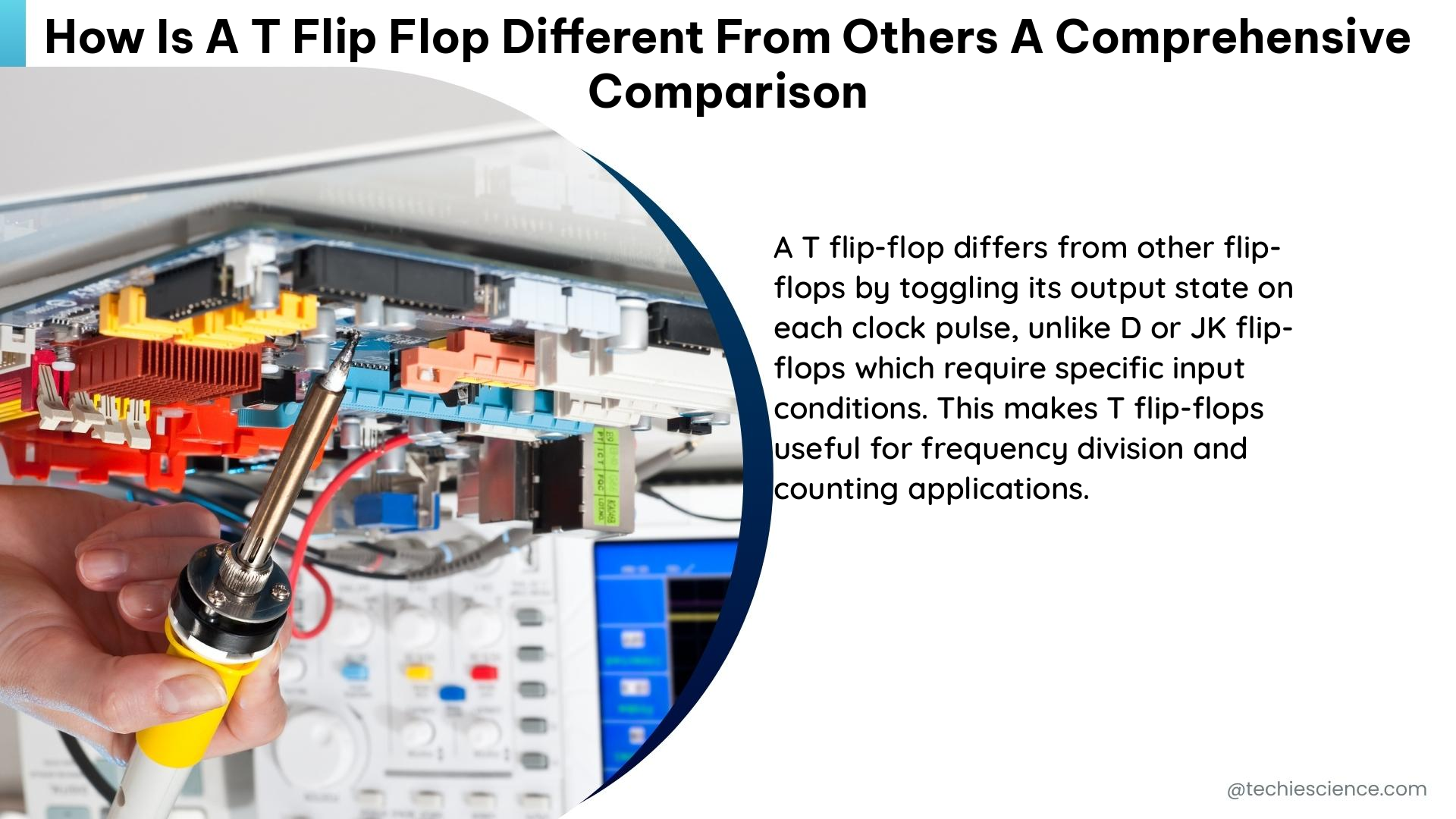A T flip-flop, also known as a Toggle flip-flop, is a unique type of flip-flop that can toggle its output every time it receives a signal. This behavior sets it apart from other flip-flop types, such as the D flip-flop, which changes its output based on the data input when clocked.
Inputs and Outputs
One of the key differences between a T flip-flop and a D flip-flop is the number and nature of their inputs and outputs. A T flip-flop has a single input, denoted as T, and a single output, Q. In contrast, a D flip-flop has two inputs: the Clock (C) input and the Data (D) input, as well as a single output, Q.
Toggling Behavior

The T flip-flop’s primary distinguishing feature is its ability to toggle its output every time it receives an input signal. This is because the T input is connected to both the set and reset inputs of the flip-flop, causing it to alternate between its two states (on and off) with each input pulse.
On the other hand, the D flip-flop will change its output to match the signal at the data input when the clock signal is applied. This means that the D flip-flop’s output will change to the value of the data input, rather than toggling between states.
Clocking Mechanism
Another key difference between T and D flip-flops is the way they are clocked. A T flip-flop is clocked by a pulse, meaning that it will change its state every time it receives a pulse. In contrast, a D flip-flop is clocked by the rising edge of a signal, so it will only change its state when the clock signal transitions from low to high.
Applications
Due to their unique toggling behavior, T flip-flops are often used in counter and shift register circuits, where they can be used to divide the clock frequency by 2. This makes them useful in applications that require frequency division, such as digital clocks and timers.
D flip-flops, on the other hand, are commonly used for input synchronization and in counter and shift register circuits, where they are used to store and shift binary data.
Formulas and Examples
The behavior of T and D flip-flops can be described using the following formulas:
T flip-flop: Q(t+1) = T’Q + TQ’
D flip-flop: Q(t+1) = D
For example, a T flip-flop can be used in a counter to divide the clock frequency by 2, while a D flip-flop can be used in a shift register to shift binary data in one direction.
Numerical Problems
Here are some numerical examples to illustrate the differences between T and D flip-flops:
- Given a T flip-flop with T = 1 and Q = 0, what will Q be after the next clock pulse? (Q = 1)
- Given a D flip-flop with D = 1 and Q = 0, what will Q be after the next clock edge? (Q = 1)
Figures and Diagrams
To further illustrate the differences between T and D flip-flops, consider the following figures:
- A T flip-flop has a single input, T, and a single output, Q.
- A D flip-flop has two inputs, Clock (C) and Data (D), and a single output, Q.
Data Points and Measurements
Here are some key data points and measurements that highlight the differences between T and D flip-flops:
- T flip-flops toggle their output every time they receive a signal.
- D flip-flops change their output based on the signal at their data input.
- T flip-flops are often used in counters and shift registers to divide the clock frequency by 2.
- D flip-flops are commonly used for input synchronization and in counters and shift registers.
- T flip-flops have one input and one output, while D flip-flops have two inputs and one output.
Conclusion
In summary, T flip-flops and D flip-flops are both types of flip-flops used to store binary data, but they differ in their behavior, inputs, outputs, and applications. T flip-flops toggle their output with each input signal, while D flip-flops change their output based on the data input when clocked. These differences make T flip-flops well-suited for frequency division in counter and shift register circuits, while D flip-flops are commonly used for input synchronization and in other counter and shift register applications.
References
- When should I use SR, D, JK, or T flip-flops?
- Flip-Flop: RS, JK, T, and D
- What is the difference between a T and a D flip-flop?
- T Flip-Flop
- Flip-Flops

The lambdageeks.com Core SME Team is a group of experienced subject matter experts from diverse scientific and technical fields including Physics, Chemistry, Technology,Electronics & Electrical Engineering, Automotive, Mechanical Engineering. Our team collaborates to create high-quality, well-researched articles on a wide range of science and technology topics for the lambdageeks.com website.
All Our Senior SME are having more than 7 Years of experience in the respective fields . They are either Working Industry Professionals or assocaited With different Universities. Refer Our Authors Page to get to know About our Core SMEs.